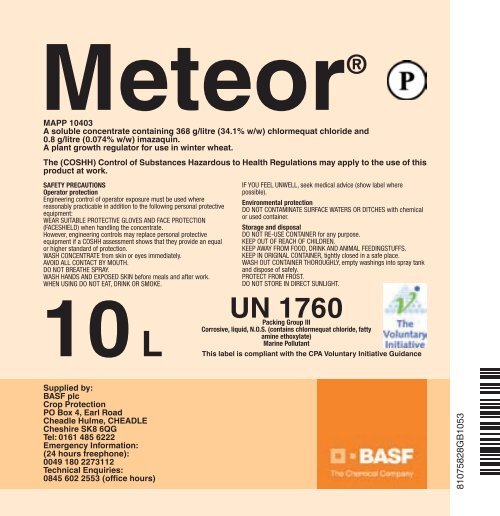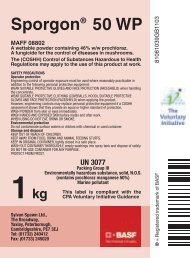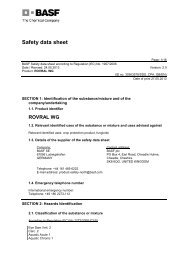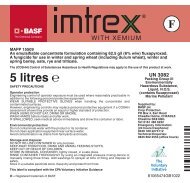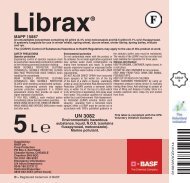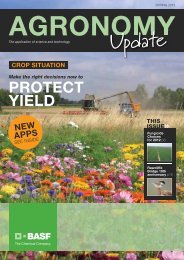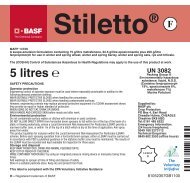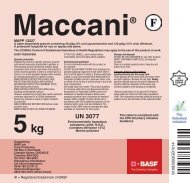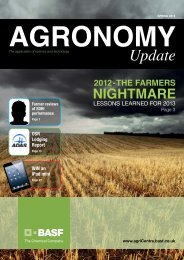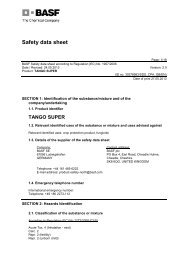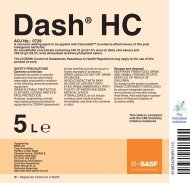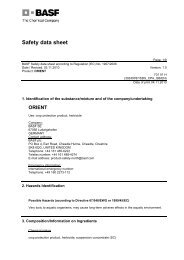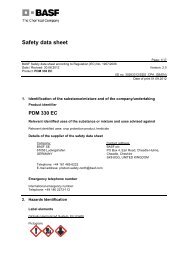Meteor® - agriCentre UK - BASF
Meteor® - agriCentre UK - BASF
Meteor® - agriCentre UK - BASF
Create successful ePaper yourself
Turn your PDF publications into a flip-book with our unique Google optimized e-Paper software.
Meteor ®<br />
MAPP 10403<br />
A soluble concentrate containing 368 g/litre (34.1% w/w) chlormequat chloride and<br />
0.8 g/litre (0.074% w/w) imazaquin.<br />
A plant growth regulator for use in winter wheat.<br />
The (COSHH) Control of Substances Hazardous to Health Regulations may apply to the use of this<br />
product at work.<br />
SAFETY PRECAUTIONS<br />
Operator protection<br />
Engineering control of operator exposure must be used where<br />
reasonably practicable in addition to the following personal protective<br />
equipment:<br />
WEAR SUITABLE PROTECTIVE GLOVES AND FACE PROTECTION<br />
(FACESHIELD) when handling the concentrate.<br />
However, engineering controls may replace personal protective<br />
equipment if a COSHH assessment shows that they provide an equal<br />
or higher standard of protection.<br />
WASH CONCENTRATE from skin or eyes immediately.<br />
AVOID ALL CONTACT BY MOUTH.<br />
DO NOT BREATHE SPRAY.<br />
WASH HANDS AND EXPOSED SKIN before meals and after work.<br />
WHEN USING DO NOT EAT, DRINK OR SMOKE.<br />
10 L<br />
IF YOU FEEL UNWELL, seek medical advice (show label where<br />
possible).<br />
Environmental protection<br />
DO NOT CONTAMINATE SURFACE WATERS OR DITCHES with chemical<br />
or used container.<br />
Storage and disposal<br />
DO NOT RE-USE CONTAINER for any purpose.<br />
KEEP OUT OF REACH OF CHILDREN.<br />
KEEP AWAY FROM FOOD, DRINK AND ANIMAL FEEDINGSTUFFS.<br />
KEEP IN ORIGINAL CONTAINER, tightly closed in a safe place.<br />
WASH OUT CONTAINER THOROUGHLY, empty washings into spray tank<br />
and dispose of safely.<br />
PROTECT FROM FROST.<br />
DO NOT STORE IN DIRECT SUNLIGHT.<br />
UN 1760<br />
Packing Group III<br />
Corrosive, liquid, N.O.S. (contains chlormequat chloride, fatty<br />
amine ethoxylate)<br />
Marine Pollutant<br />
This label is compliant with the CPA Voluntary Initiative Guidance<br />
Supplied by:<br />
<strong>BASF</strong> plc<br />
Crop Protection<br />
PO Box 4, Earl Road<br />
Cheadle Hulme, CHEADLE<br />
Cheshire SK8 6QG<br />
Tel: 0161 485 6222<br />
Emergency Information:<br />
(24 hours freephone):<br />
0049 180 2273112<br />
Technical Enquiries:<br />
0845 602 2553 (office hours)<br />
81075828GB1053
Meteor ®<br />
A soluble concentrate containing 368 g/litre<br />
chlormequat chloride<br />
and 0.8 g/litre imazaquin.<br />
DANGER:<br />
MAY BE CORROSIVE TO METALS.<br />
HARMFUL IF SWALLOWED.<br />
CAUSES SERIOUS EYE DAMAGE.<br />
HARMFUL IF INHALED.<br />
TOXIC TO AQUATIC LIFE WITH LONG<br />
LASTING EFFECTS.<br />
TO AVOID RISKS TO HUMAN HEALTH AND<br />
THE ENVIRONMENT, COMPLY WITH THE<br />
INSTRUCTIONS FOR USE.<br />
AVOID BREATHING VAPOURS.<br />
WEAR EYE/FACE PROTECTION.<br />
IF IN EYES: RINSE CAUTIOUSLY WITH WATER FOR SEVERAL<br />
MINUTES. REMOVE CONTACT LENSES, IF PRESENT AND<br />
EASY TO DO. CONTINUE RINSING.<br />
IMMEDIATELY CALL A POISON CENTRE OR DOCTOR/<br />
PHYSICIAN.<br />
ABSORB SPILLAGE TO PREVENT MATERIAL DAMAGE.<br />
DISPOSE OF CONTENTS/CONTAINER IN ACCORDANCE WITH<br />
LOCAL REGULATIONS<br />
To avoid risks to human health and the environment, comply with the instructions for use<br />
This product is approved under the Control of Pesticides Regulations 1986<br />
IMPORTANT INFORMATION<br />
FOR USE ONLY AS AN AGRICULTURAL PLANT GROWTH REGULATOR, as directed below:<br />
Crop<br />
Maximum individual<br />
dose (litres product/<br />
hectare)<br />
Maximum total dose (litres<br />
product/hectare/crop)<br />
Latest time of application<br />
Winter wheat 2.5 2.5 Before second node<br />
detectable stage<br />
READ THE LABEL BEFORE USE. USING THIS PRODUCT IN A MANNER THAT IS INCONSISTENT WITH<br />
THE LABEL MAY BE AN OFFENCE. FOLLOW THE CODE OF PRACTICE FOR USING PLANT PROTECTION<br />
PRODUCTS.
DIRECTIONS FOR USE<br />
IMPORTANT: This information is approved as part of the Product Label. All instructions within this section must be read<br />
carefully in order to obtain safe and successful use of this product.<br />
1. Restrictions/Warnings<br />
Do not apply Meteor when the crop is wet or if rain is imminent.<br />
On soils of low fertility, best results will be obtained where adequate nitrogen fertiliser is used.<br />
DO NOT apply Meteor to undersown crops.<br />
Do not use straw from Meteor treated cereals as a horticultural growth medium or as a mulch.<br />
2. Growth Regulation<br />
Meteor contains two active ingredients, imazaquin and chlormequat chloride.<br />
These active ingredients from different chemical groups have two modes of action, both of which can regulate the growth of<br />
winter wheat and provide protection against lodging.<br />
Applied together as Meteor, imazaquin and chlormequat chloride can enhance yield by affecting the growth of the aerial<br />
structure (stem, leaves and ears) of the wheat plant.<br />
3. Crops<br />
Meteor is for use on high yield Winter Wheat growing systems. It should be applied to crops during good growing conditions<br />
and to those which are at risk from lodging.<br />
It is approved for use on all varieties of Winter Wheat (except Durum Wheat) on any soil type.<br />
Maximum application rate<br />
Maximum dose : 2.5 l/ha in any one growing season. This may be applied as a single application or as a split dose<br />
sequence.<br />
Latest timing<br />
Before 2nd node detectable stage.<br />
Recommended dose and timings<br />
Single application:<br />
2.5 l/ha May be applied from leaf sheath lengthening up to and including first node detectable.<br />
Split application:<br />
1.75 l/ha First dose from tillers formed to leaf sheath lengthening.<br />
0.75 l/ha Second dose from leaf sheath erect up to and including first node detectable.
4. Mixing and Spraying<br />
Mixing<br />
1. Three quarters fill the tank with water<br />
2. Shake the can well<br />
3. Add Meteor while re-circulating<br />
4. If tank-mixing, add the other product(s) individually ONLY when each has fully dispersed.<br />
5. Fill the tank<br />
6. Maintain circulation while spraying<br />
Caution is needed with mixtures of liquid nitrogen fertilisers and Meteor as scorching may occur in certain circumstances.<br />
Water volume<br />
200 litres/hectare.<br />
Spray quality<br />
Fine or medium (BCPC definition), within the following range:<br />
F110/0.6 to 1.6/3.0<br />
HC 80 to 90/0.6 to 1.6/3.0<br />
Speed<br />
6–8 km/h for tractor-mounted or trailed sprayers.<br />
Boom height<br />
40–50 cm above the crop.<br />
5. Trademark Acknowledgements<br />
Meteor is a registered trademark of <strong>BASF</strong>.<br />
The following does not form part of the product label under the Control of Pesticides Regulations 1986.<br />
With many products there is a general risk of resistance developing to the active ingredients. For this reason a change in<br />
activity cannot be ruled out. It is generally impossible to predict with certainty how resistance may develop because there<br />
are so many crop- and use- connected ways of influencing this. We therefore have to exclude liability for damage or loss<br />
attributable to any such resistance that may develop. To help minimise any loss in activity the <strong>BASF</strong> recommended rate should<br />
in all events be adhered to.<br />
Numerous, particularly regional or regionally attributable, factors can influence the activity of the product. Examples include<br />
weather and soil conditions, crop plant varieties, crop rotation, treatment times, application amounts, admixture with other<br />
products, appearance of organisms resistant to active ingredients and spraying techniques. Under particular conditions a<br />
change in activity or damage to plants cannot be ruled out. The manufacturer or supplier is therefore unable to accept any<br />
liability in such circumstances. All goods supplied by us are of high grade and we believe them to be suitable, but as we<br />
cannot exercise control over their mixing or use or the weather conditions during and after application, which may affect the<br />
performance of the material, all conditions and warranties, statutory or otherwise, as to the quality or fitness for any purpose<br />
of our goods are excluded and no responsibility will be accepted by us for any damage or injury whatsoever arising from their<br />
storage, handling, application or use; but nothing should be deemed to exclude or restrict any liability upon us which cannot<br />
be excluded or restricted under the provisions of the Unfair Contract Terms Act 1977 or any similar applicable law.
Section 6 of the Health and Safety at Work Act<br />
Additional Product Safety Information<br />
The product label provides information on a specific pesticidal use of the product; do not use otherwise, unless you have assessed<br />
any potential hazard involved, the safety measures required and that the particular use has “off-label” approval or is otherwise<br />
permitted under the Control of Pesticides Regulations.<br />
The information on this label is based on the best available information including data from test results<br />
Safety Data Sheet<br />
1. Identification of the substance/mixture and of the company/undertaking<br />
Product identifier<br />
METEOR<br />
Relevant identified uses of the substance or mixture and uses advised against<br />
Relevant identified uses: crop protection product, growth regulator<br />
Details of the supplier of the safety data sheet<br />
Company:<br />
<strong>BASF</strong> SE<br />
67056 Ludwigshafen<br />
GERMANY<br />
Contact address:<br />
<strong>BASF</strong> plc<br />
PO Box 4, Earl Road, Cheadle Hulme, Cheadle, Cheshire<br />
SK8 6QG, UNITED KINGDOM<br />
Telephone: +44 161 485-6222<br />
E-mail address: product-safety-north@basf.com<br />
Emergency telephone number<br />
International emergency number: Telephone: +49 180 2273-112<br />
2. Hazards Identification<br />
Label elements<br />
Globally Harmonized System, EU (GHS)<br />
Pictogram:<br />
Signal Word: Danger<br />
Hazard Statement:<br />
H290<br />
May be corrosive to metals.<br />
H318<br />
Causes serious eye damage.<br />
H332<br />
Harmful if inhaled.<br />
H302<br />
Harmful if swallowed.<br />
H411<br />
Toxic to aquatic life with long lasting effects.<br />
EUH401<br />
To avoid risks to human health and the environment, comply with the instructions for use.<br />
Precautionary Statements (Prevention):<br />
P280d<br />
Wear eye/face protection.<br />
P261d<br />
Avoid breathing vapours.
P271<br />
P270<br />
P264<br />
P234<br />
Use only outdoors or in a well-ventilated area.<br />
Do no eat, drink or smoke when using this product.<br />
Wash with plenty of water and soap thoroughly after handling.<br />
Keep only in original container.<br />
Precautionary Statements (Response):<br />
P310<br />
Immediately call a POISON CENTER or doctor/physician.<br />
P305 + P351 + P338 IF IN EYES: Rinse cautiously with water for several minutes. Remove contact lenses, if present and easy to do.<br />
Continue rinsing.<br />
P304 + P340 IF INHALED: Remove victim to fresh air and keep at rest in a position comfortable for breathing.<br />
P301 + P312 IF SWALLOWED: Call a POISON CENTER or doctor/physician if you feel unwell.<br />
P330<br />
Rinse mouth.<br />
P390<br />
Absorb spillage to prevent material damage.<br />
Precautionary Statements (Disposal):<br />
P501<br />
Dispose of contents/container to hazardous or special waste collection point.<br />
According to Regulation (EC) No 1272/2008 [CLP]<br />
Hazard determining component(s) for labelling: chlormequat chloride (ISO); 2- chloroethyltrimethylammonium chloride, Amines, tallow<br />
alkyl, ethoxylated<br />
According to Directive 67/548/EEC or 1999/45/EC<br />
Classification/labelling in accordance with <strong>UK</strong> regulations.<br />
Hazard symbol(s)<br />
Xn<br />
Harmful.<br />
N<br />
Dangerous for the environment.<br />
R-phrase(s)<br />
R20/22 Harmful by inhalation and if swallowed.<br />
R41<br />
Risk of serious damage to eyes.<br />
R51/53 Toxic to aquatic organisms, may cause long-term adverse effects in the aquatic environment.<br />
S-phrase(s)<br />
S2<br />
Keep out of the reach of children.<br />
S13<br />
Keep away from food, drink and animal feeding stuffs.<br />
S20/21 When using do not eat, drink or smoke.<br />
S25<br />
Avoid contact with eyes.<br />
S26<br />
In case of contact with eyes, rinse immediately with plenty of water and seek medical advice.<br />
S29/35 Do not empty into drains, this material and its container must be disposed of in a safe way.<br />
S39<br />
Wear eye/face protection.<br />
S46<br />
If swallowed, seek medical advice immediately and show this container orlabel.<br />
S57<br />
Use appropriate container to avoid environmental contamination.<br />
Hazard determining component(s) for labelling: chlormequat chloride (ISO); 2- chloroethyltrimethylammonium chloride, Amines, tallow<br />
alkyl, ethoxylated<br />
Classification of the substance or mixture<br />
According to Regulation (EC) No 1272/2008 [CLP]<br />
Met. Corr. 1<br />
Acute Tox. 4 (Inhalation - vapour)<br />
Acute Tox. 4 (oral)<br />
Eye Dam./Irrit. 1<br />
Aquatic Chronic 2<br />
According to Directive 67/548/EEC or 1999/45/EC<br />
Possible Hazards:<br />
Harmful by inhalation.<br />
Harmful if swallowed.<br />
Irritating to eyes.<br />
Harmful to aquatic organisms, may cause long-term adverse effects in the aquatic environment.<br />
For the classifications not written out in full in this section the full text can be found in section 16.
Other hazards<br />
According to Regulation (EC) No 1272/2008 [CLP]<br />
See section 12 - Results of PBT and vPvB assessment.<br />
If applicable information is provided in this section on other hazards which do not result in classification but which may contribute to the<br />
overall hazards of the substance or mixture.<br />
3. Composition/Information on Ingredients<br />
Mixtures<br />
Chemical nature<br />
crop protection product, growth regulator, Soluble concentrate (SL)<br />
Hazardous ingredients (GHS)<br />
according to Regulation (EC) No. 1272/2008<br />
chlormequat chloride (ISO); 2-chloroethyltrimethylammonium chloride<br />
Content (W/W): 34.1 %<br />
Acute Tox. 4 (oral)<br />
CAS Number: 999-81-5<br />
Acute Tox. 4 (dermal)<br />
EC-Number: 213-666-4<br />
H312, H302<br />
INDEX-Number: 007-003-00-6<br />
imazaquin<br />
Content (W/W): 0.07 % Aquatic Acute 1<br />
CAS Number: 81335-37-7 Aquatic Chronic 1<br />
H400, H410<br />
Amines, tallow alkyl, ethoxylated<br />
Content (W/W): < 10 %<br />
Acute Tox. 4 (oral)<br />
CAS Number: 61791-26-2 Eye Dam./Irrit. 1<br />
Aquatic Acute 1<br />
H318, H302, H400<br />
Choline chloride<br />
Content (W/W):
4. First-Aid Measures<br />
Description of first aid measures<br />
Show container, label and/or safety data sheet to physician.<br />
Remove contaminated clothing.<br />
Show container, label and/or safety data sheet to physician.<br />
If inhaled:<br />
Keep patient calm, remove to fresh air, seek medical attention. Immediately inhale corticosteroid dose aerosol.<br />
On skin contact:<br />
Immediately wash thoroughly with plenty of water, apply sterile dressings, consult a skin specialist.<br />
On contact with eyes:<br />
Immediately wash affected eyes for at least 15 minutes under running water with eyelids held open, consult an eye specialist.<br />
On ingestion:<br />
Immediately rinse mouth and then drink 200-300 ml of water, seek medical attention.<br />
Most important symptoms and effects, both acute and delayed<br />
Symptoms: The most important known symptoms and effects are described in the labelling (see section 2) and/or in section 11., Further<br />
important symptoms and effects are so far not known.<br />
Indication of any immediate medical attention and special treatment needed<br />
Treatment: Treat according to symptoms (decontamination, vital functions), no known specific antidote.<br />
5. Fire-Fighting Measures<br />
Extinguishing media<br />
Suitable extinguishing media:<br />
water spray, carbon dioxide, foam, dry powder<br />
Special hazards arising from the substance or mixture<br />
carbon monoxide, hydrogen chloride, Carbon dioxide, nitrogen oxides, organochloric compounds<br />
The substances/groups of substances mentioned can be released in case of fire.<br />
Advice for fire-fighters<br />
Special protective equipment:<br />
Wear self-contained breathing apparatus and chemical-protective clothing.<br />
Further information:<br />
In case of fire and/or explosion do not breathe fumes. Keep containers cool by spraying with water if exposed to fire. Collect contaminated<br />
extinguishing water separately, do not allow to reach sewage or effluent systems. Dispose of fire debris and contaminated extinguishing<br />
water in accordance with official regulations.<br />
6. Accidental Release Measures<br />
Personal precautions, protective equipment and emergency procedures<br />
Use personal protective clothing. Avoid contact with the skin, eyes and clothing. Do not breathe vapour/spray.<br />
Environmental precautions<br />
Do not discharge into the subsoil/soil. Do not discharge into drains/surface waters/groundwater.<br />
Do not allow contamination of public drains or surface or ground waters. Inform local water plc if spillage enters drains and the Environment<br />
Agency (England & Wales), the Scottish Environmental Protection Agency (Scotland), or the Environment and Heritage Service (Northern<br />
Ireland) if it enters surface or ground waters. Keep people and animals away.<br />
Methods and material for containment and cleaning up<br />
For small amounts: Pick up with suitable absorbent material (e.g. sand, sawdust, general-purpose binder, kieselguhr).<br />
For large amounts: Dike spillage. Pump off product.<br />
Cleaning operations should be carried out only while wearing breathing apparatus. Collect waste in suitable containers, which can be<br />
labeled and sealed. Incinerate or take to a special waste disposal site in accordance with local authority regulations. Clean contaminated<br />
floors and objects thoroughly with water and detergents, observing environmental regulations.
Reference to other sections<br />
Information regarding exposure controls/personal protection and disposal considerations can be found in section 8 and 13.<br />
7. Handling and Storage<br />
Precautions for safe handling<br />
No special measures necessary if stored and handled correctly. Ensure thorough ventilation of stores and work areas. When using do not<br />
eat, drink or smoke. Hands and/or face should be washed before breaks and at the end of the shift.<br />
Protection against fire and explosion:<br />
No special precautions necessary. The substance/product is non-combustible. Product is not explosive.<br />
Conditions for safe storage, including any incompatibilities<br />
Segregate from foods and animal feeds.<br />
Unsuitable materials for containers: Copper, brass, zinc.<br />
Further information on storage conditions: Keep away from heat. Protect from direct sunlight.<br />
Specific end use(s)<br />
For the relevant identified use(s) listed in Section 1 the advice mentioned in this section 7 is to be observed.<br />
8. Exposure Controls/Personal Protection<br />
Control parameters<br />
Components with occupational exposure limits<br />
Refer to the current edition of HSE Guidance Note EH40 Occupational Exposure Limits (United Kingdom). For normal use and handling<br />
refer to the product label/leaflet. In all other cases the following apply.<br />
Exposure controls<br />
Personal protective equipment<br />
Respiratory protection:<br />
Suitable respiratory protection for higher concentrations or long-term effect: Combination filter for gases/vapours of organic, inorganic, acid<br />
inorganic and alkaline compounds (e.g. EN 14387 Type ABEK).<br />
Hand protection:<br />
Suitable chemical resistant safety gloves (EN 374) also with prolonged, direct contact (Recommended: Protective index 6, corresponding<br />
> 480 minutes of permeation time according to EN 374): E.g. nitrile rubber (0.4 mm), chloroprene rubber (0.5 mm), butyl rubber (0.7 mm)<br />
and other<br />
Eye protection:<br />
Tightly fitting safety goggles (splash goggles) (e.g. EN 166)<br />
Body protection:<br />
Body protection must be chosen depending on activity and possible exposure, e.g. apron, protecting boots, chemical-protection suit<br />
(according to EN 14605 in case of splashes or EN ISO 13982 in case of dust).<br />
General safety and hygiene measures<br />
The statements on personal protective equipment in the instructions for use apply when handling crop-protection agents in finalconsumer<br />
packing. Wearing of closed work clothing is recommended. Store work clothing separately. Keep away from food, drink and<br />
animal<br />
feeding stuffs.<br />
9. Physical and Chemical Properties<br />
Information on basic physical and chemical properties<br />
Form:<br />
liquid<br />
Colour:<br />
pale gold<br />
Odour:<br />
amine-like, fish-like<br />
Odour threshold:<br />
not determined<br />
pH value: approx. 5 - 7 (20 °C) (measured with the undiluted substance)
crystallization temperature: -12 °C<br />
onset of boiling: approx. 106 °C<br />
Flash point:<br />
No flash point - Measurement made up to the boiling point.<br />
Evaporation rate:<br />
not applicable<br />
Flammability:<br />
not determined<br />
Lower explosion limit: As a result of our experience with this product and our knowledge of its composition we do not expect<br />
any hazard as long as the product is used appropriately and in accordance with the intended use.<br />
Upper explosion limit: As a result of our experience with this product and our knowledge of its composition we do not expect<br />
any hazard as long as the product is used appropriately and in accordance with the intended use.<br />
Ignition temperature: 423 °C<br />
Vapour pressure: approx. 23 mbar (20 °C) Information applies to the solvent.<br />
Density: approx. 1.08 g/cm3 (20 °C)<br />
Relative vapour density (air): not determined<br />
Solubility in water: soluble (20 °C)<br />
Information on: chlormequat chloride (ISO); 2-chloroethyltrimethylammonium chloride<br />
Partitioning coefficient n-octanol/water (log Kow): -3.44<br />
(25 °C)<br />
Information on: Imazaquin techn.<br />
Partitioning coefficient n-octanol/water (log Kow): -0.93<br />
(20 °C; pH value: 5)<br />
-1.29<br />
(20 °C; pH value: 7)<br />
-1.69<br />
(20 °C; pH value: 9)<br />
----------------------------------<br />
Thermal decomposition: not determined<br />
Viscosity, dynamic:<br />
not determined<br />
Explosion hazard:<br />
not explosive<br />
Fire promoting properties: not fire-propagating<br />
Other information<br />
Other information:<br />
If necessary, information on other physical and chemical parameters is indicated in this section.<br />
10. Stability and Reactivity<br />
Reactivity<br />
No hazardous reactions if stored and handled as prescribed/indicated.<br />
Corrosion to metals:<br />
Corrosive effect on: aluminum mild steel<br />
Corrosion rate > 6.25 mm/a using 7075-T6 or AZ5GU-<br />
Chemical stability<br />
The product is stable if stored and handled as prescribed/indicated.<br />
Possibility of hazardous reactions<br />
No hazardous reactions if stored and handled as prescribed/indicated.<br />
Conditions to avoid<br />
See MSDS section 7 - Handling and storage.<br />
Incompatible materials<br />
Substances to avoid:<br />
strong bases, strong acids, strong oxidizing agents<br />
Hazardous decomposition products<br />
Hazardous decomposition products: No hazardous decomposition products if stored and handled as prescribed/indicated.<br />
T6
11. Toxicological Information<br />
Information on toxicological effects<br />
Acute toxicity<br />
Assessment of acute toxicity:<br />
Of moderate toxicity after single ingestion. Of moderate toxicity after short-term inhalation. Virtually nontoxic after a single skin contact.<br />
Experimental/calculated data: LD50 rat (oral): > 1,467 mg/kg<br />
LC50 rat (by inhalation): > 2.3 mg/l 4 h<br />
LD50 rat (dermal): > 2,000 mg/kg<br />
No mortality was observed.<br />
Irritation<br />
Assessment of irritating effects:<br />
May cause severe damage to the eyes. Not irritating to the skin.<br />
Experimental/calculated data:<br />
Skin corrosion/irritation rabbit: non-irritant<br />
Serious eye damage/irritation rabbit: Risk of serious damage to eyes.<br />
Respiratory/Skin sensitization<br />
Assessment of sensitization:<br />
There is no evidence of a skin-sensitizing potential. The product has not been tested. The statement has been derived from substances/<br />
products of a similar structure or composition.<br />
Experimental/calculated data:<br />
modified Buehler test guinea pig: Skin sensitizing effects were not observed in animal studies.<br />
Germ cell mutagenicity<br />
Assessment of mutagenicity:<br />
The product has not been tested. The statement has been derived from the properties of the individual components. Mutagenicity tests<br />
revealed no genotoxic potential.<br />
Carcinogenicity<br />
Assessment of carcinogenicity:<br />
The product has not been tested. The statement has been derived from the properties of the individual components. The results of<br />
various animal studies gave no indication of a carcinogenic effect.<br />
Reproductive toxicity<br />
Assessment of reproduction toxicity:<br />
The product has not been tested. The statement has been derived from the properties of the individual components. The results of animal<br />
studies gave no indication of a fertility impairing effect.<br />
Developmental toxicity<br />
Assessment of teratogenicity:<br />
The product has not been tested. The statement has been derived from the properties of the individual components. Animal studies gave<br />
no indication of a developmental toxic effect at doses that were not toxic to the parental animals.<br />
Repeated dose toxicity and Specific target organ toxicity (repeated exposure)<br />
Assessment of repeated dose toxicity:<br />
The product has not been tested. The statement has been derived from the properties of the individual components. No substancespecific<br />
organtoxicity was observed after repeated administration to animals.
Other relevant toxicity information<br />
Misuse can be harmful to health.<br />
Assessment of aquatic toxicity:<br />
Acutely toxic for aquatic organisms. May cause long-term adverse effects in the aquatic environment.<br />
Toxicity to fish:<br />
LC50 (96 h) 15 mg/l, Oncorhynchus mykiss<br />
Aquatic invertebrates:<br />
EC50 (48 h) 27.3 mg/l, Daphnia magna<br />
Aquatic plants:<br />
EC50 (72 h) 51 mg/l, Pseudokirchneriella subcapitata EC50 (72 h) 9.8 mg/l, Anabaena flos-aquae<br />
Persistence and degradability<br />
Assessment biodegradation and elimination (H2O):<br />
The product has not been tested. The statement has been derived from the properties of the individual components.<br />
Information on: chlormequat chloride (ISO); 2-chloroethyltrimethylammonium chloride<br />
Assessment biodegradation and elimination (H2O):<br />
Readily biodegradable (according to OECD criteria).<br />
Information on: Imazaquin techn.<br />
Assessment biodegradation and elimination (H2O):<br />
Not readily biodegradable (by OECD criteria).<br />
----------------------------------<br />
Bioaccumulative potential<br />
Assessment bioaccumulation potential:<br />
The product has not been tested. The statement has been derived from the properties of the individual components.<br />
Information on: chlormequat chloride (ISO); 2-chloroethyltrimethylammonium chloride<br />
Bioaccumulation potential:<br />
Because of the n-octanol/water distribution coefficient (log Pow) accumulation in organisms is not to be expected.<br />
Information on: Imazaquin techn.<br />
Bioaccumulation potential:<br />
No significant accumulation in organisms is expected as a result of the distribution coefficient of n- octanol/water (log Pow).<br />
----------------------------------<br />
Mobility in soil (and other compartments if available)<br />
Assessment transport between environmental compartments:<br />
The product has not been tested. The statement has been derived from the properties of the individual components.<br />
Information on: chlormequat chloride (ISO); 2-chloroethyltrimethylammonium chloride<br />
Assessment transport between environmental compartments:<br />
Following exposure to soil, the product trickles away and can - dependant on degradation - be transported to deeper soil areas with larger<br />
water loads.<br />
Information on: Imazaquin techn.<br />
Assessment transport between environmental compartments:<br />
Following exposure to soil, the product trickles away and can - dependant on degradation - be transported to deeper soil areas with larger<br />
water loads.<br />
----------------------------------<br />
Results of PBT and vPvB assessment<br />
The product does not contain a substance fullfilling the PBT (persistent/bioaccumulative/toxic) criteria or the vPvB (very persistent/very<br />
bioaccumulative) criteria.<br />
Other adverse effects<br />
The product does not contain substances that are listed in Annex I of Regulation (EC) 2037/2000 on substances that deplete the ozone<br />
layer.<br />
Additional information<br />
Other ecotoxicological advice: Do not discharge product into the environment without control.
13. Disposal Considerations<br />
Waste treatment methods<br />
Must be sent to a suitable incineration plant, observing local regulations.<br />
The <strong>UK</strong> Environmental Protection (Duty of Care) Regulations (EP) and amendments should be noted (United Kingdom). This product<br />
any any uncleaned containers must be disposed of as hazardous waste in accordance with the 2005 Hazardous Waste Regulations and<br />
amendments (United Kingdom).<br />
Contaminated packaging:<br />
Contaminated packaging should be emptied as far as possible and disposed of in the same manner as the substance/product.<br />
14. Transport Information<br />
Land transport<br />
ADR<br />
UN number: UN 1760<br />
UN proper shipping name: CORROSIVE LIQUID, N.O.S. (contains CHLORMEQUAT CHLORIDE, FATTY<br />
AMINE ETHOXYLATE)<br />
Transport hazard class(es): 8, EHSM<br />
Packing group:<br />
III<br />
Environmental hazards:<br />
yes<br />
Special precuations for user: Tunnel code: E<br />
RID<br />
UN number: UN 1760<br />
UN proper shipping name: CORROSIVE LIQUID, N.O.S. (contains CHLORMEQUAT CHLORIDE, FATTY<br />
AMINE ETHOXYLATE)<br />
Transport hazard class(es): 8, EHSM<br />
Packing group:<br />
III<br />
Environmental hazards:<br />
yes<br />
Special precuations for user: None known<br />
Inland waterway transport<br />
ADN<br />
UN number: UN 1760<br />
UN proper shipping name: CORROSIVE LIQUID, N.O.S. (contains CHLORMEQUAT CHLORIDE, FATTY<br />
AMINE ETHOXYLATE)<br />
Transport hazard class(es): 8, EHSM<br />
Packing group:<br />
III<br />
Environmental hazards:<br />
yes<br />
Special precuations for user: None known<br />
Transport in inland waterway<br />
vessel:<br />
Not evaluated<br />
Sea transport<br />
IMDG<br />
UN number: UN 1760<br />
UN proper shipping name: CORROSIVE LIQUID, N.O.S. (contains CHLORMEQUAT CHLORIDE, FATTY<br />
AMINE ETHOXYLATE)<br />
Transport hazard class(es): 8, EHSM<br />
Packing group:<br />
III<br />
Environmental hazards:<br />
yes<br />
Marine pollutant:<br />
YES<br />
Special precuations for user: None known
Air transport<br />
IATA/ICAO<br />
UN number: UN 1760<br />
UN proper shipping name: CORROSIVE LIQUID, N.O.S. (contains CHLORMEQUAT CHLORIDE, FATTY<br />
AMINE ETHOXYLATE)<br />
Transport hazard class(es): 8<br />
Packing group:<br />
III<br />
Environmental hazards:<br />
No Mark as dangerous for the environment is needed<br />
Special precuations for user: None known<br />
Transport in bulk according to Annex II or MARPOL 73/78 and the IBC Code<br />
Regulation:<br />
Not evaluated<br />
Shipment approved:<br />
Not evaluated<br />
Pollution name:<br />
Not evaluated<br />
Pollution category:<br />
Not evaluated<br />
Ship Type:<br />
Not evaluated<br />
Further information<br />
This product is subject to the most recent edition of ‚The Carriage of Dangerous Goods and Use of Transportable Pressure Equipment<br />
Regulations‘ and their amendments (United Kingdom).<br />
15. Regulatory Information<br />
Safety, health and environmental regulations/legislation specific for the substance or mixture<br />
To avoid risks to man and the environment, comply with the instructions for use.<br />
The data should be considered when making any assessment under the Control of Substances Hazardous to Health Regulations<br />
(COSHH), and related guidance, for example, ‚COSHH Essentials‘ (United Kingdom).<br />
This product is classified under the Chemicals (Hazard Information and Packaging) Regulations, (CHIP) (United Kingdom).<br />
Chemical Safety Assessment<br />
Advice on product handling can be found in sections 7 and 8 of this safety data sheet.<br />
16. Other Information<br />
For proper and safe use of this product, please refer to the approval conditions laid down on the product label.<br />
Full text of the classifications, including the indication of danger, the hazard symbols, the R phrases, and the hazard statements, if<br />
mentioned in section 2 or 3:<br />
Xn<br />
Harmful.<br />
N<br />
Dangerous for the environment.<br />
21/22 Harmful in contact with skin and if swallowed.<br />
52/53 Harmful to aquatic organisms, may cause long-term adverse effects in the aquatic environment.<br />
22 Harmful if swallowed.<br />
41 Risk of serious damage to eyes.<br />
50 Very toxic to aquatic organisms.<br />
Met. Corr.<br />
Substance or mixture corrosive to metals<br />
Acute Tox.<br />
Acute toxicity<br />
Eye Dam./Irrit. Serious eye damage/eye irritation<br />
Aquatic Chronic Hazardous to the aquatic environment - chronic<br />
Aquatic Acute Hazardous to the aquatic environment - acute<br />
H312<br />
Harmful in contact with skin.<br />
H302<br />
Harmful if swallowed.<br />
H400<br />
Very toxic to aquatic life.<br />
H410<br />
Very toxic to aquatic life with long lasting effects.<br />
H318<br />
Causes serious eye damage.<br />
If you have any queries relating to this MSDS, it‘s contents or any other product safety related questions, please write to the following e-mail<br />
address: product-safety-north@basf.com<br />
(Version 4.0)


